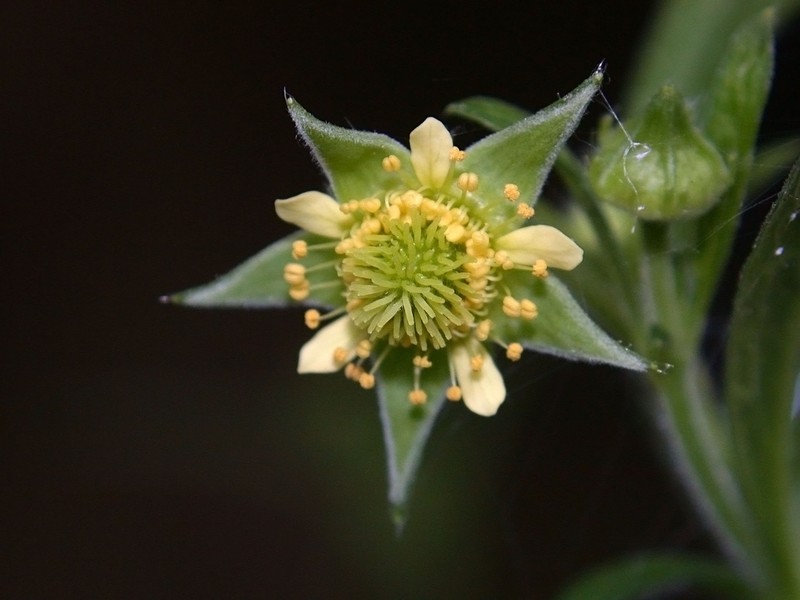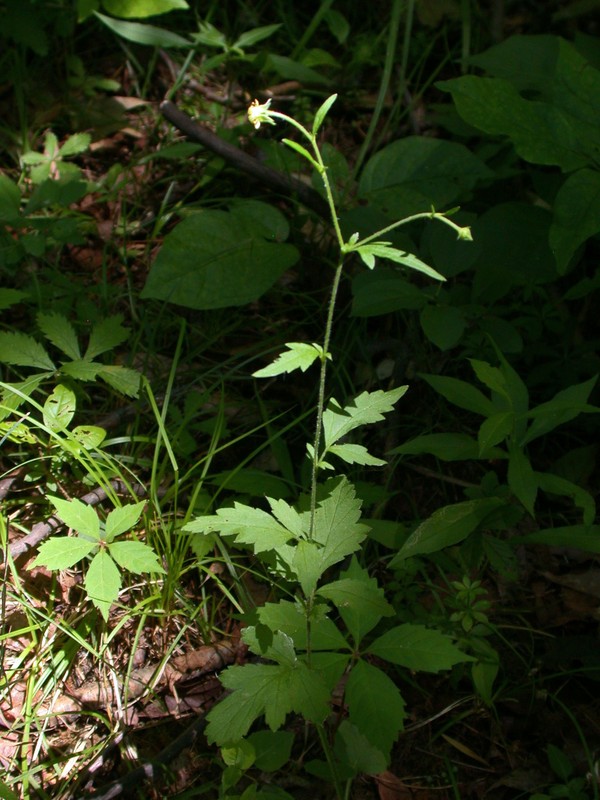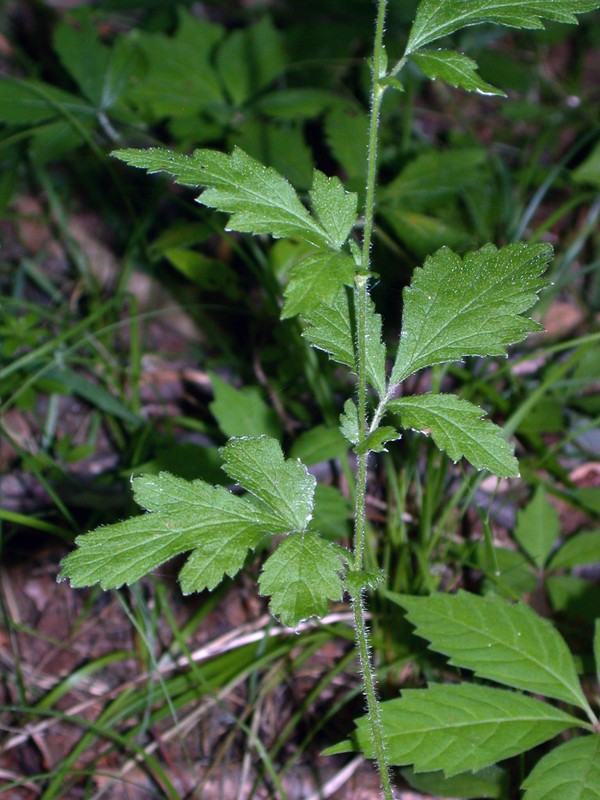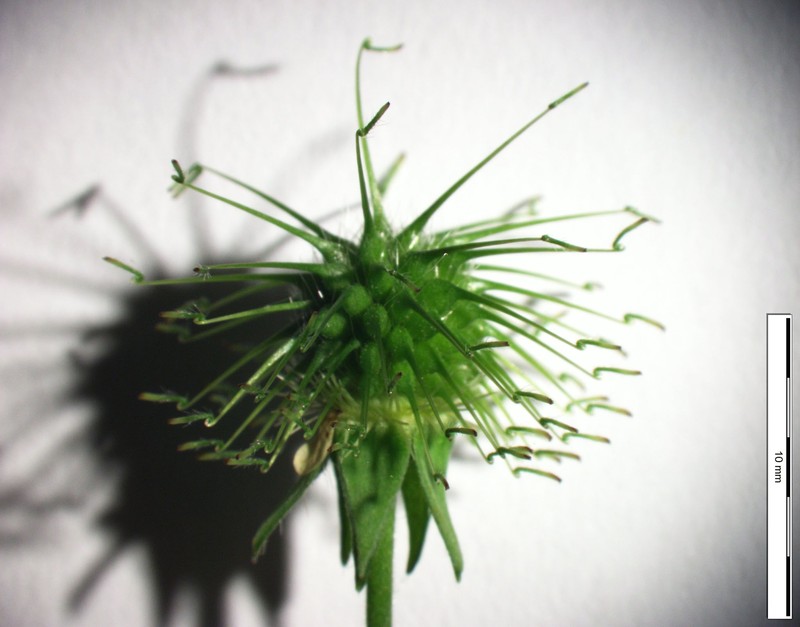Cream-colored Avens
Geum virginianum L.
- Class
- Dicotyledoneae (Dicots)
- Family
- Rosaceae (Rose Family)
- State Protection
- Threatened
Listed as Threatened by New York State: likely to become Endangered in the foreseeable future. For animals, taking, importation, transportation, or possession is prohibited, except under license or permit. For plants, removal or damage without the consent of the landowner is prohibited.
- Federal Protection
- Not Listed
- State Conservation Status Rank
- S2
Imperiled in New York - Very vulnerable to disappearing from New York due to rarity or other factors; typically 6 to 20 populations or locations in New York, very few individuals, very restricted range, few remaining acres (or miles of stream), and/or steep declines.
- Global Conservation Status Rank
- G5
Secure globally - Common in the world; widespread and abundant (but may be rare in some parts of its range).
Summary
Did you know?
The root of rough avens has been used medicinally in the past to treat all sorts of illnesses. One of its common names, chocolate root, refers to the chocolate-like beverage it produces when the root is boiled in milk. There are many historical sites for this species in New York so it may be overlooked because it resembles two common avens species, Geum laciniatum and Geum canadense.
State Ranking Justification
There are 15 existing populations but only one of them has more than 50 plants. Half of the populations do not have any specific information about their numbers or condition. There are 22 historical occurrences and most of these have not been resurveyed.
Short-term Trends
None of the current populations have been revisited in recent years so there is no information on short-term trends.
Long-term Trends
It is difficult to know the long-term trend of this species in New York because the plant is probably often overlooked. There are more historical records than existing populations, so the trend appears to be negative, but more targeted surveys need to be done to better understand the long-term trend. Most populations are under 50 plants so trends could decline rapidly.
Conservation and Management
Threats
Any human disturbance, such as logging or development, that would affect the woodland habitat where this plant grows, could be a threat. Woodland invasive species such as shrub honeysuckles or barberry are also a threat.
Conservation Strategies and Management Practices
Buffers need to be established around populations to prevent changes in hydrology and direct impact by logging or development. Invasive plants such as garlic mustard, barberry, or shrub honeysuckles should not be allowed to invade the site.
Research Needs
There is no understanding of the specific habitat that the species prefers since its woodland locations do not seem to be much different from the surrounding forest and it has also been found in many types of habitats. More research is needed into habitat preference and specific characters needed for a good search image. This will help narrow down places to search and improve predictive modeling.
Habitat
Habitat
Routh Avens has been found in a very wide range of habitats in the state. These include Appalachian oak-hickory forests, northern-hardwood forests, woodlands on limestone bedrock and on sand dunes, muddy riverbanks, forested swamps, marshes, and roadsides. Detailed information on the microhabitat this species occupies is lacking for many of our extant records. More research is needed to determine which of these habitats the species does best in, and the reasons for its rarity despite an apparently broad habitat tolerance (New York Natural Heritage Program 2007). Dry woods and thickets or rocky banks (Fernald 1970). Moist upland woods (Gleason & Cronquist 1991).
Associated Ecological Communities
- Alvar woodland
(guide)
A subset of the limestone woodland community restricted to the alvar region in Jefferson County, New York.
- Beech-maple mesic forest*
(guide)
A hardwood forest with sugar maple and American beech codominant. This is a broadly defined community type with several variants. These forests occur on moist, well-drained, usually acid soils. Common associates are yellow birch, white ash, hop hornbeam, and red maple.
- Great Lakes dunes
(guide)
A community dominated by grasses and shrubs that occurs on active and stabilized sand dunes along the shores of the Great Lakes. Unstable dunes are sparsely vegetated, whereas the vegetation of stable dunes is more dense, and can eventually become forested.
- Hemlock-northern hardwood forest
(guide)
A mixed forest that typically occurs on middle to lower slopes of ravines, on cool, mid-elevation slopes, and on moist, well-drained sites at the margins of swamps. Eastern hemlock is present and is often the most abundant tree in the forest.
- Shallow emergent marsh
(guide)
A marsh meadow community that occurs on soils that are permanently saturated and seasonally flooded. This marsh is better drained than a deep emergent marsh; water depths may range from 6 in to 3.3 ft (15 cm to 1 m) during flood stages, but the water level usually drops by mid to late summer and the soil is exposed during an average year.
- Silver maple-ash swamp
(guide)
A hardwood basin swamp that typically occurs in poorly-drained depressions or along the borders of large lakes, and less frequently in poorly drained soils along rivers. These sites are characterized by uniformly wet conditions with minimal seasonal fluctuations in water levels. The dominant trees are usually silver maple and green ash.
* probable association but not confirmed.
Associated Species
- Carex garberi (elk sedge)
- Carex lupuliformis (false hop sedge)
- Carex molesta (troublesome sedge)
- Carex nigromarginata (black-edged sedge)
- Carex pensylvanica (Pennsylvania sedge)
- Carya ovata
- Cynoglossum virginianum var. boreale
- Dracocephalum parviflorum (American dragon-head)
- Eurybia macrophylla (large-leaved-aster)
- Fraxinus americana (white ash)
- Hepatica nobilis var. obtusa
- Ostrya virginiana (hop hornbeam, ironwood)
- Quercus alba (white oak)
- Quercus velutina (black oak)
- Rubus occidentalis (black raspberry)
- Solidago arguta
Range
New York State Distribution
There are records for rough avens scattered through most of the state outside of the Adirondacks.
Global Distribution
Geum virginianum reaches the northeastern edge of its range in Vermont, and is found in most of the U.S. east of the Mississippi: as far south as Georgia, and as far west as Alabama, Missouri, and Minnesota. In Canada it is known only from Ontario.
Identification Comments
General Description
Rough Avens is a perennial herb, growing up to 1 m tall, with hairy stems. The lowest leaves are 3- parted, on long petioles, with the terminal segment usually much larger than the other two. The upper leaves become smaller and on shorter petioles the higher up the stem they are, the uppermost being simple and nearly sessile. The flowers have 5 tiny(2-4 mm) cream-colored, minutely hairy petals only 1/2 to 2/3 as long as the green sepals. The fruit are achenes, on an egg-shaped, densely hairy head (receptacle), and are dispersed by hooks on the ends of the long, persistent styles.
Best Life Stage for Proper Identification
Rough avens is best identified when in flower.
Similar Species
Geum canadense has pure white petals, longer or only slightly shorter than the sepals. Geum laciniatum also has short white petals, but the petals and flower stalks have long hairs, unlike the short velevety hairs of G. virginianum.
Best Time to See
This species is best identified when it is flowering in June or July.
- Flowering
- Fruiting
The time of year you would expect to find Cream-colored Avens flowering and fruiting in New York.
Cream-colored Avens Images
Taxonomy
Cream-colored Avens
Geum virginianum L.
- Kingdom Plantae
- Phylum Anthophyta
- Class Dicotyledoneae
(Dicots)
- Order Rosales
- Family Rosaceae (Rose Family)
- Order Rosales
- Class Dicotyledoneae
(Dicots)
- Phylum Anthophyta
Additional Common Names
- Herb-bennet
- Rough Avens
Synonyms
- Geum flavum (Porter) E.P. Bicknell
- Geum hirsutum Muhl. ex Link
Additional Resources
Best Identification Reference
Fernald, M.L. 1950. Gray's manual of botany. 8th edition. D. Van Nostrand, New York. 1632 pp.
Other References
Gleason, Henry A. and A. Cronquist. 1991. Manual of Vascular Plants of Northeastern United States and Adjacent Canada. The New York Botanical Garden, Bronx, New York. 910 pp.
Holmgren, Noel. 1998. The Illustrated Companion to Gleason and Cronquist's Manual. Illustrations of the Vascular Plants of Northeastern United States and Adjacent Canada. The New York Botanical Garden, Bronx, New York.
New York Natural Heritage Program. 2010. Biotics database. New York Natural Heritage Program. New York State Department of Environmental Conservation. Albany, NY.
New York Natural Heritage Program. 2024. New York Natural Heritage Program Databases. Albany, NY.
Newcomb, Lawrence. 1977. Newcomb's Wildflower Guide: An Ingenious New Key System for Quick, Positive Field Identification of the Wildflowers, Flowering Shrubs, and Vines of Northeastern and North-Central North America. Little, Brown and Company. Boston.
Rhoads, Ann F. and Timothy A. Block. 2000. The Plants of Pennsylvania, an Illustrated Manual. University of Pennsylvania Press, Philadelphia, PA.
Voss, E.G. 1985. Michigan Flora. Part II. Dicots (Saururaceae - Cornaceae). Cranbrook Institute of Science and University of Michigan Herbarium. Ann Arbor, Michigan. 724 pp.
Weldy, T. and D. Werier. 2010. New York flora atlas. [S.M. Landry, K.N. Campbell, and L.D. Mabe (original application development), Florida Center for Community Design and Research http://www.fccdr.usf.edu/. University of South Florida http://www.usf.edu/]. New York Flora Association http://newyork.plantatlas.usf.edu/, Albany, New York
Weldy, Troy W. and David Werier. 2005. New York Flora Atlas. [S.M. Landry, K.N. Campbell, and L.D. Mabe (original application development), Florida Center for Community Design and Research. University of South Florida]. New York Flora Association, Albany, NY. Available on the web at (http://newyork.plantatlas.usf.edu/).
Links
About This Guide
Information for this guide was last updated on: August 8, 2021
Please cite this page as:
New York Natural Heritage Program. 2024.
Online Conservation Guide for
Geum virginianum.
Available from: https://guides.nynhp.org/rough-avens/.
Accessed July 26, 2024.



